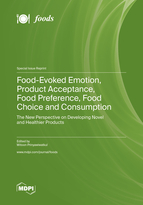Food-Evoked Emotion, Product Acceptance, Food Preference, Food Choice and Consumption: The New Perspective on Developing Novel and Healthier Products
A special issue of Foods (ISSN 2304-8158). This special issue belongs to the section "Sensory and Consumer Sciences".
Deadline for manuscript submissions: closed (20 October 2022) | Viewed by 58680
Special Issue Editor
Interests: sensory sciences; consumer research; value-added products; healthier product development
Special Issues, Collections and Topics in MDPI journals
Special Issue Information
Dear Colleagues,
Eating is a necessity to survive. However, food is more than just a source of nutrients—it is a source of basic pleasure as well as aesthetic experiences. Eating and drinking and lifestyle can promote health or may cause a number of potential health risk and ethical concerns related to food chain and production. Today, consumers are more health-conscious and more educated about what goes into their foods. Many consumers want healthier versions of retailed food products, such as those with low-sodium content. These consumers are concerned about their health benefit or risk associated with food consumption. At present, globalization allows consumers to be exposed to various cuisines which can be readily available to them. Additionally, with the world population increasing rapidly, alternative food sources and food production will be needed to support sustainability. A potential alternative protein source (e.g., from edible insect protein), for instance, will likely be needed. The question, therefore, is: “Would consumers be willing to consume this, and would they like it?” Based on many studies, food choice, acceptance, preference, and consumption are affected by a large number of factors, including both intrinsic and extrinsic factors and cues.
It is known that food elicits emotion. Measuring food-evoked emotions is a topical topic in sensory and consumer sciences. Emotions are becoming a critical component in designing products that meet consumers’ needs and expectations. Emotional profiles may effectively differentiate products with similar sensory characteristics and hedonic ratings. Emotion profiles and ratings may provide additional information that goes beyond traditional hedonic ratings and may provide more insight toward food choice. Several studies have reported emotional responses to food and their relationships to product acceptability. In addition to sensory quality of food, food-evoked emotion has been reported to be critical in predicting consumer's food preference, acceptance, and food choice, which are, in turn, critical in developing novel products. Appropriate health benefit information has also been reported to impact emotion, purchase decisions, and food choices. Human senses and cues play an instrumental role in food choice and intake, emotion, and product acceptance; hence, understanding their roles and importance is critical.
This Special Issue of Foods aims to publish both original and cutting-edge research and comprehensive reviews contributing to a deeper understanding of food-evoked emotion, food choice, preference, acceptance, and consumption, which is a valuable source of information for research and development, product innovation, and marketing that goes beyond traditional sensory preference and acceptability measurement. Papers from multi- and interdisciplinary perspectives, such as food and sensory sciences, culinology and gastronomy, nutrition and health sciences, psychology, business and marketing, and consumer behavior are highly desirable and very welcome.
Prof. Dr. Witoon Prinyawiwatkul
Guest Editor
Manuscript Submission Information
Manuscripts should be submitted online at www.mdpi.com by registering and logging in to this website. Once you are registered, click here to go to the submission form. Manuscripts can be submitted until the deadline. All submissions that pass pre-check are peer-reviewed. Accepted papers will be published continuously in the journal (as soon as accepted) and will be listed together on the special issue website. Research articles, review articles as well as short communications are invited. For planned papers, a title and short abstract (about 100 words) can be sent to the Editorial Office for announcement on this website.
Submitted manuscripts should not have been published previously, nor be under consideration for publication elsewhere (except conference proceedings papers). All manuscripts are thoroughly refereed through a single-blind peer-review process. A guide for authors and other relevant information for submission of manuscripts is available on the Instructions for Authors page. Foods is an international peer-reviewed open access semimonthly journal published by MDPI.
Please visit the Instructions for Authors page before submitting a manuscript. The Article Processing Charge (APC) for publication in this open access journal is 2900 CHF (Swiss Francs). Submitted papers should be well formatted and use good English. Authors may use MDPI's English editing service prior to publication or during author revisions.
Keywords
- food-evoked emotions
- sensory liking and consumer acceptance
- food preference
- willingness to try
- purchase intent
- food choice
- food intake
- health risk and benefit statement







